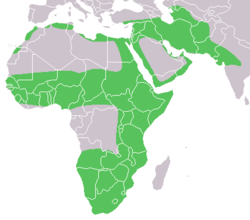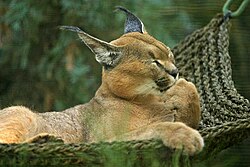Wikijunior:Big Cats/Caracal

The Caracal, also called Persian lynx or "African lynx", is a medium-sized wild cat. The caracal resembles a lynx and is related. Caracals are labeled as small cats but are the heaviest of all small cats as well as the fastest.
Where do caracals live?
[edit | edit source]
Caracals are distributed over Africa and West Asia. Their habitat is dry steppes and semi-deserts, but also woodlands, savanna, and scrub forest. They are solitary, or paired, territorial cats.
What do caracals look like?
[edit | edit source]
The length is 65 cm (about 2 ft), plus 30 cm tail (about 1 foot). It has longer legs and a slimmer appearance than a lynx. The color of the fur may be wine-red, gray or sand-colored. Young caracals bear reddish spots on the underside, while adults do not have markings except for black spots above the eyes. The caracal has long, tufted black ears, which also explain the origin of its name--"karakulak", Turkish for "black ears"
What do caracals eat, and how do they catch their prey?
[edit | edit source]
A caracal may survive without drinking for a long period - the water demand is satisfied with the body fluids of the prey. It hunts at night (but in colder seasons also in the daytime) for rodents and hares; rarely it may even attack a gazelle, a small antelope or a young ostrich.
They are picky eaters, and discard the internal organs of the mammals they catch, partially pluck the fur off of hyraxes and larger kills, and avoid eating hair by shearing meat neatly from the skin. But they will eat the feathers of small birds and are tolerant of rotten meat. Caracal ears are controlled by 20 different muscles. Tufts of fur on their ears help them pinpoint their prey accurately.
They are most well-known, however, for their skill with hunting birds; a caracal is able to snatch a bird in flight, sometimes more than one at a time. Caracals can jump and climb exceptionally well, which enables it to catch hyraxes better than probably any other carnivore.
Fun facts
[edit | edit source]- The caracal is the fastest cat in its size range.
- Sometimes called a desert lynx or African lynx because of its tufted ears, it is not a lynx at all.
- Tame caracals are sometimes used to assist hunters in Iran and India.
- Wild caracals in the Western Cape of South Africa are attacking and eating domesticated cats. The cause of this is confusing to cat owners as there seems to be plenty of food in the wild for the caracal to eat. One can assume that domestic cats are easier to catch than wild prey.
